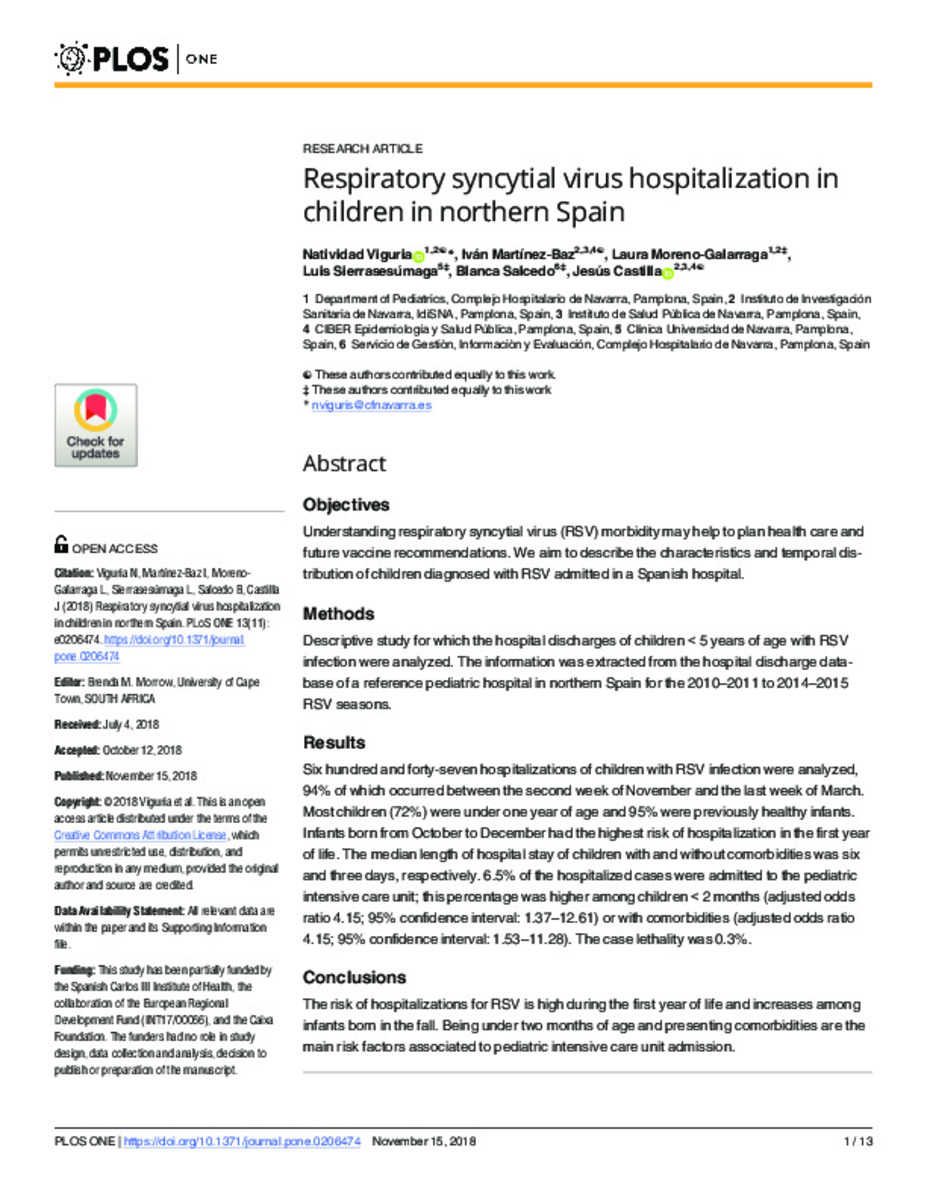Full metadata record
| DC Field | Value | Language |
|---|---|---|
| dc.creator | Viguria, N. (Natividad) | - |
| dc.creator | Martínez-Baz, I. (Iván) | - |
| dc.creator | Moreno-Galarraga, L. (Laura) | - |
| dc.creator | Sierrasesumaga, L. (Luis) | - |
| dc.creator | Salcedo, B. (Blanca) | - |
| dc.creator | Castilla, J. (Jesús) | - |
| dc.date.accessioned | 2022-11-08T11:28:21Z | - |
| dc.date.available | 2022-11-08T11:28:21Z | - |
| dc.date.issued | 2018 | - |
| dc.identifier.citation | Viguria, N. (Natividad); Martínez-Baz, I. (Iván); Moreno-Galarraga, L. (Laura); et al. "Respiratory syncytial virus hospitalization in children in northern Spain". Plos one. 13 (11), 2018, e0206474 | es_ES |
| dc.identifier.issn | 1932-6203 | - |
| dc.identifier.uri | https://hdl.handle.net/10171/64621 | - |
| dc.description.abstract | Objectives: Understanding respiratory syncytial virus (RSV) morbidity may help to plan health care and future vaccine recommendations. We aim to describe the characteristics and temporal distribution of children diagnosed with RSV admitted in a Spanish hospital. Methods: Descriptive study for which the hospital discharges of children < 5 years of age with RSV infection were analyzed. The information was extracted from the hospital discharge database of a reference pediatric hospital in northern Spain for the 2010-2011 to 2014-2015 RSV seasons. Results: Six hundred and forty-seven hospitalizations of children with RSV infection were analyzed, 94% of which occurred between the second week of November and the last week of March. Most children (72%) were under one year of age and 95% were previously healthy infants. Infants born from October to December had the highest risk of hospitalization in the first year of life. The median length of hospital stay of children with and without comorbidities was six and three days, respectively. 6.5% of the hospitalized cases were admitted to the pediatric intensive care unit; this percentage was higher among children < 2 months (adjusted odds ratio 4.15; 95% confidence interval: 1.37-12.61) or with comorbidities (adjusted odds ratio 4.15; 95% confidence interval: 1.53-11.28). The case lethality was 0.3%. Conclusions: The risk of hospitalizations for RSV is high during the first year of life and increases among infants born in the fall. Being under two months of age and presenting comorbidities are the main risk factors associated to pediatric intensive care unit admission. | es_ES |
| dc.description.sponsorship | This study has been partially funded by the Spanish Carlos III Institute of Health, the collaboration of the European Regional Development Fund (INT17/00066), and the Caixa Foundation. The funders had no role in study design, data collection and analysis, decision to publish or preparation of the manuscript. | es_ES |
| dc.language.iso | eng | es_ES |
| dc.publisher | Public Library of Science | es_ES |
| dc.rights | info:eu-repo/semantics/openAccess | es_ES |
| dc.subject | Respiratory syncytial virus (RSV) | es_ES |
| dc.subject | Health care | es_ES |
| dc.subject | Vaccine recommendations | es_ES |
| dc.title | Respiratory syncytial virus hospitalization in children in northern Spain | es_ES |
| dc.type | info:eu-repo/semantics/article | es_ES |
| dc.description.note | This is an open access article distributed under the terms of the Creative Commons Attribution License, which permits unrestricted use, distribution, and reproduction in any medium, provided the original author and source are credited. | es_ES |
| dc.identifier.doi | 10.1371/journal.pone.0206474 | - |
| dadun.citation.number | 11 | es_ES |
| dadun.citation.publicationName | Plos one | es_ES |
| dadun.citation.startingPage | e0206474 | es_ES |
| dadun.citation.volume | 13 | es_ES |
Files in This Item:
Statistics and impact
Items in Dadun are protected by copyright, with all rights reserved, unless otherwise indicated.






